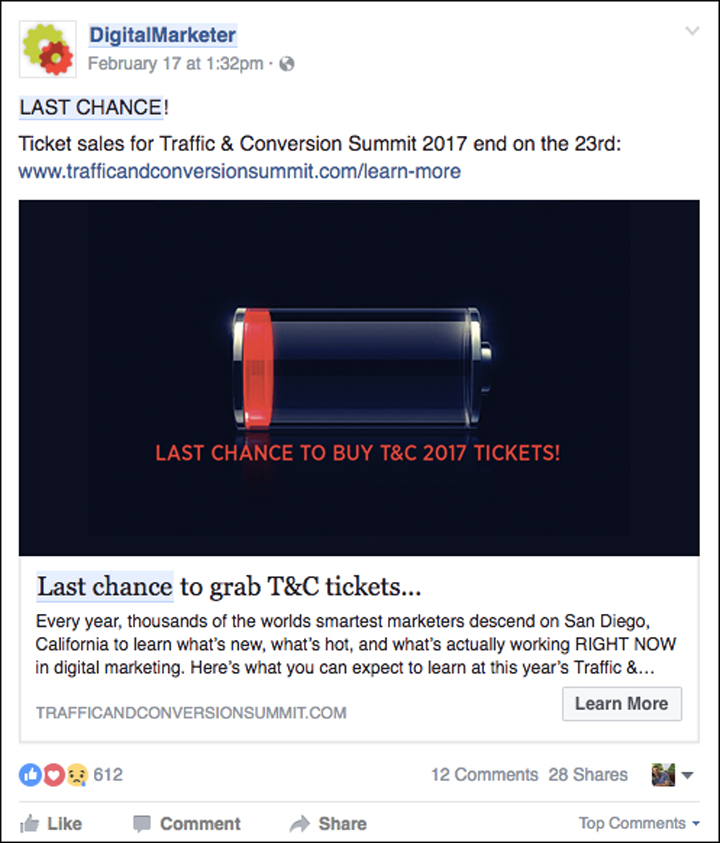What I’m going to share with you may blow your mind. Especially if you’re a consumer psychology geek like me.
Before I begin, let me share that I’m a huge fan of Digital Marketer and their Perpetual Traffic podcast. Each week, I’ll tune in and listen to their awesome podcast and learn something new about Facebook advertising or other dimensions of paid traffic.
On a recent Perpetual Traffic episode, Digital Marketer CEO Ryan Deiss shared seven amazing insights on how you can create kickass ads.
These were drawn largely from the work of Robert Cialdini (read about his 6 weapons of influence here), as well as various other advertising gurus and luminaries.
What I loved about the episode were the examples given on how these insights could be applied. They helped me to crystallise the ideas in a concrete fashion and apply what I’ve learned to create more effective online copy.
So what were the 7 pointers?
#1 Make Your Offer Novel, Unique and Distinctive
Human beings love novelty. We also crave unique and distinctive experiences.
This old psychological trick is one of the reasons why ads which feature headlines like “New”, “First Time”, “Available NOW” captures the attention of their audiences.
What happens if your product or service has been around for some time?
Well, according to Ryan Deiss, you should ask yourself what you can do to make it “feel new”.
Is there a fresh angle which you can take? Can you link your product to something new or unique? How can you highlight something distinctive about your product?
Here are some examples:
- Using the word “MAJOR ANNOUNCEMENT” as an opening to your Facebook ad copy
- Making your product launch read like a news piece, eg “Breaking News”
- Sharing a unique customer experience, eg “Over 10,000 New Clients from using this unusual technique.”
The Facebook ad from PillPack show how novelty could be used to attract your audience’s attention.
#2 Make Your Plan Sound Really Simple
There is power in simple and elegant designs. Steve Jobs knew that. So do the Japanese.
However, it can be really tough for many of us to do.
“(Simple) is really hard to do because what it means is sometimes you got to pull back on your claims. It means that you have to not explain every little nuance and detail of the product which is really, really hard if it’s your baby.” – Ryan Deiss
Simple is the new orange. It is the reason why Donald Trump triumphed over Hilary Clinton to become the new US President.
So do how you simplify?
- Reduce jargons from your Facebook ads
- Keep to the simplest visuals and designs
- Cut clutter
- Minimise to a maximum of three (or four) benefits in your ad copy
Here is an example of a simple yet effective Facebook ad from Digital Marketer itself.
Courtesy of Digital Marketer
#3 Ask an Opening Question to Trigger a Desire for Consistency and Commitment
OK, this one is a little deeper, but it goes like this:
- You begin your copy by asking your prospect a question
- This could be a rhetorical question, like “Is your product or service good?” or “Do you consider yourself to be smart?”
- Internally, your prospect is likely to answer “Yes”
- Follow up with copy that affirms that belief. This could be something like this “If your product is great, I’d like you to sell more of it. Here’s how.”
Once again, this came from one of Robert Cialdini’s 6 Weapons of Influence – consistency and commitment. It is a psychological trick which rides on our innate compulsion to be consistent in how we present ourselves once we made an initial commitment.
Here are more examples of trigger questions which you can use:
- Are you a generous and kind-hearted person?
- Are you a successful marketer?
- Do you have a great and awesome product?
And an excellent example of how this is used in a Facebook ad.
Courtesy of brandmuscle
#4 Pre-expose Your Audience to a Concept Linked to a Desired Emotion
Now this works well when we introduce an evocative visual or design to trigger a desired emotion in our audiences.
Think about what you wish your audience to feel when they see your ad. Would it be fear? Joy? Pain? Laughter? Or feeling sexy?
Use a strong visual to stimulate that feeling. Like the example below from Digital Marketer for an upcoming event which they organise.
Courtesy of Digital Marketer
Or this other example here taken from Mark Massing on LinkedIn which probably triggers fear from folks with soaring bills.
#5 Create a Positive Mental Link to Your Offer
For this, ask yourself what mental links and associations you wish to tap into and positively associate with your offer.
Often, nostalgia works well here. By creating positive associations with something that people love, you help to reduce fear, improve trust and raise the likelihood of a purchase.
You can use metaphors for this purpose (read my article on marketing metaphors to learn more).
Here are some examples:
- “Airbnb for dogs” for a pet hotel
- “Panadol for the ears” if you’re a new radio station
- “Tastes just like Mom’s Cooking” for a new food product
What metaphor or association comes to mind when you see this ad?
Courtesy of imagination is magic
#6 Create an Open Loop to Hold Attention
Taken from the Zeigarnik Effect, the idea which Ryan has here is to create an open loop or a cliffhanger so that you can continually grip the attention of your audience.
Much of the Harry Potter series of books and movies used this effect. As are soap operas – and space soap operas like the “Star Wars” series.
Here are some ways to do so:
- Ask a question or end your advertising message with a cliffhanger
- Roll out your products or services in an episodic and sequential manner
- Give your customers opportunities to “collect” products or experiences that form part of a greater set
- Weave multiple “tasks” or “stages” into your processes
A good example of how this can be done is shown by DBS’ Sparks miniseries. Sparks is an online series of videos which traces the story of a couple of bankers in DBS, complete with drama and tension. This is a great way to humanize a corporate bank while enthralling its audiences.
Courtesy of DBS Sparks
#7 Create a Visual or Mental Portal for Your Audience to Pass Through
Considered the “creepiest” of all his findings, Deiss explained how bringing your audience through different “portals” could improve intimacy.
“There is something fascinating and magical about moving from one room to another, passing through a door. It really does change the way that we think. It is an attention reset.” – Ryan Deiss
Apparently, this is an old trick used by sales people and pickup artists. If you can get somebody to move from one place to another, they’re more likely to make a decision in your favour.
For example, during a product launch, you could move from one location to another and bring your audience with you. This could also be represented online using videos, audio recordings, text, or pictures.
Examples of this portal effect include stories that involve some form of “escapism”, ie:
- Alice in Wonderland
- Chronicles of Narnia (through the wardrobe)
- A marriage where a bride and groom walks through the church aisle
An example of how this could be done online is shown below. Here, you are invited to browse a “library” of resources from Digital Marketer.
Courtesy of Digital Marketer
Hope that the above was enlightening for you. I’m certainly going to apply these principles for my next piece of online content or ad. What about you?










Great article to read about Facebook ads. I like to share with my colleagues’ thanks for sharing. Pls visit my website to know more about our works: https://www.pepytechnologies.com/